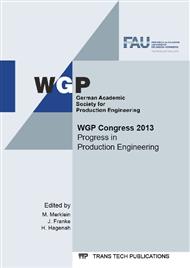[1]
H.-J. Schmelzer, W. Sesselmann, Geschäftsprozessmanagement in der Praxis. Kunden zufrieden stellen - Produktivität steigern - Wert erhöhen; 6. Aufl. München: Hanser, 2008, pp.1-2
DOI: 10.3139/9783446467095.fm
Google Scholar
[2]
K. Deimel, R. Isemann, S. Müller, Kosten- und Erlösrechnung, in: Pearson Studium, 2006, p.36
Google Scholar
[3]
H.-J. Bullinger, D. Spath, H.-J. Warnecke, E. Westkämper, Handbuch Unternehmensorganisa-tion: Strategien, Planung, Umsetzung, Springer; Auflage: 3., neu bearb. Aufl. 2009, p.189
DOI: 10.1007/978-3-540-87595-6
Google Scholar
[4]
G. Schuh et. al, Konsortial Benchmarking "Production Systems", Werkzeugmaschinenlabor WZL der RWTH Aachen, (2011)
Google Scholar
[5]
C. Brecher, Integrative Production Technology for High-Wage Countries, Springer, Berlin, 2012, pp.21-23.
Google Scholar
[6]
S. Kinkel, Produktionsverlagerungen in Zeiten der Krise: Zusammenhalt von Kapazitäten statt Kostenflucht, Frauenhofer-Institut für System- und Innovationsforschung (ISI), Karlsruhe, (2009)
Google Scholar
[7]
H.-J., Warnecke, Die fraktale Fabrik – Revolution der Unternehmenskultur, Rowohlt, 1996, p.108
Google Scholar
[8]
H. Kagermann, Deutschlands Zukunft als Produktionsstandort sichern - Umsetzungsempfehl-ungen für das Zukunftsprojekt Industrie 4.0, Berlin, 2012, p.10
Google Scholar
[9]
G. Moore, Cramming more components onto integrated circuits, Electronics Magazine,1965, p.4
Google Scholar
[10]
M. Broy, Cyber-Physical Systems, Springer, Berlin, 2010, pp.17-32.
Google Scholar
[11]
R. Rajkumar, L. Insup, S. Lui, J. Stankovic, Cyberphysical systems: The next computing revolution, Proceedings of Design Automation Conference (DAC) 2010 47th ACM/IEEE, VDE, p.731.
Google Scholar
[12]
B. Vastag, Exabytes: Documenting the 'digital age' and huge growth in computing capacity, 2011, http://www.washingtonpost.com/wp-dyn/content/article/2011/02/10/ AR2011021004916.html (05.01.2013)
Google Scholar
[13]
CISCO, The Internet of Things, 2012 http://blogs.cisco.com.
Google Scholar
[14]
J.G. G. Harris, B. Ives, I. Junglas, The Genie Is Out of the Bottle: Managing the Infiltration of Consumer IT Into the Workforce, 2011, http://www.accenture.com/us-en/Pages/insight-managing-infiltration-consumer-it-workforce.aspx
Google Scholar
[15]
M. Hecking, Soziale Firmennetzwerke, Wege aus der E-Mail Flut, http://www.manager-magazin.de/unternehmen/it/0,2828,887179,00.html (15.03.2013)
Google Scholar
[16]
A. Pentland, Kommunikation ist der Schlüssel. In: Harvard Business Manager, 2012, pp.36-48.
Google Scholar
[17]
G. Schalk, Brain-Computer Symbiosis, Journal for neural engineering, 5(1), 2008, pp.1-2
Google Scholar
[18]
A. Gesher, 2010, Friction in Human-Computer Symbiosis: Kasparov on Chess, http://www.palantir.com/2010/03/friction-in-human-computer-symbiosis-kasparov-on-chess/ (05.01.2013)
Google Scholar
[19]
M. Hilbert, What Drives the Global Growth of Information?, Ideas Economy: Information 2011, Santa Clara, California, USA, June 7th-8th 2011.
Google Scholar


